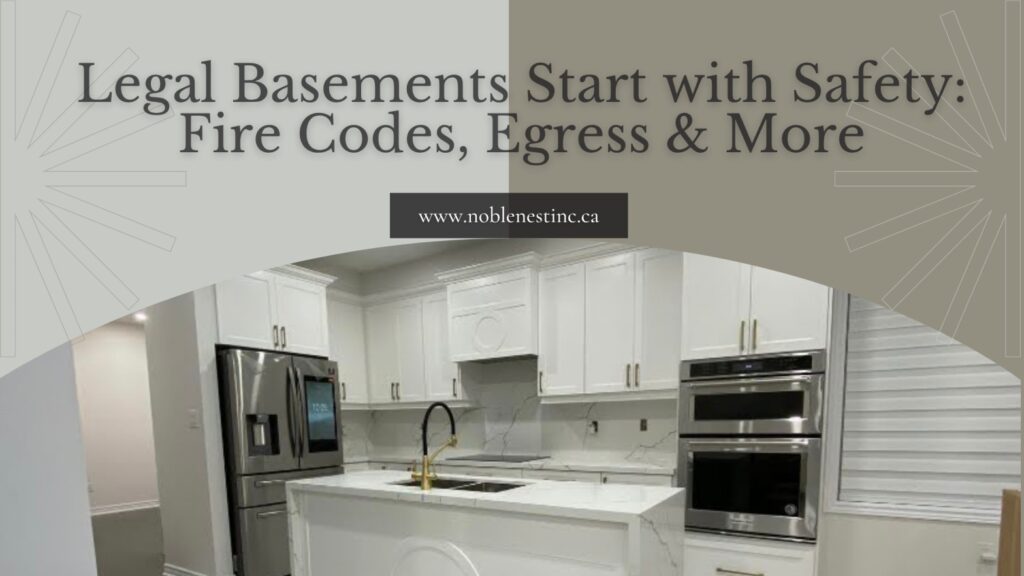Converting a basement into a livable space can be a smart move—whether you’re creating a rental unit, expanding your living area, or increasing your home’s value. But before you start dreaming of cozy lounges and income-producing suites, there’s one non-negotiable truth you need to understand: a legal basement starts with safety.
Safety isn’t just about peace of mind—it’s the foundation of legal compliance. Municipal building codes are designed to ensure that all habitable spaces meet specific standards that protect the occupants in case of an emergency. For basements, this means adhering to strict fire codes, installing proper egress windows, and following essential building and mechanical regulations. Here’s what you need to know.
- Why Legal Compliance Matters
Creating a legal basement construction isn’t just about avoiding fines—it’s about liability and protection. If you build or rent out an illegal basement that doesn’t meet code and a fire or injury occurs, the consequences can be severe: you may be personally liable, your insurance may not cover damages, and you could be ordered to vacate or remove the unit altogether.
Municipal inspectors prioritize safety above all else, and for good reason. Fires, carbon monoxide leaks, and blocked exits are major risks in poorly constructed basement spaces. The good news? By focusing on a few key safety features, you can set your basement renovation on the right path from the beginning.
- Understanding Fire Codes
Fire safety regulations vary slightly from one municipality to another, but some core principles are universal. Here’s what you’ll typically need:
🔥 Fire-Rated Materials
Walls and ceilings separating a basement unit from the main house often require fire-rated drywall or fire-resistant insulation. This barrier helps contain fires, giving residents more time to escape and emergency services more time to respond.
🔥 Smoke and Carbon Monoxide Detectors
Legal basements must include interconnected smoke and carbon monoxide detectors. These should be installed in every bedroom, hallway, and common area. Interconnected systems ensure that if one alarm is triggered, all alarms in the house sound—alerting everyone, regardless of where the danger starts.
🔥 Fire Separations and Doors
Basement suites often need fire-rated doors (typically 20–45 minutes fire-resistant) on utility rooms and between units. This is especially important if the furnace, water heater, or electrical panel is shared.
- The Importance of Egress
One of the most commonly overlooked—and most strictly enforced—safety requirements for legal basements is egress, or safe exit routes.
🪟 Egress Windows
Every bedroom in a basement must have a large, easily accessible window that allows a person to escape in the event of a fire or emergency. These windows must:
- Open without special tools or keys
- Provide a minimum opening area (often around 5.7 square feet)
- Be no higher than a certain distance from the floor (usually around 44 inches)
- Open directly to the outside (not into a window well that’s too small or obstructed)
Window wells must also meet code if they’re used in place of full-size windows. They need to be large enough for someone to climb out and may require built-in ladders if the depth exceeds certain limits.
🚪 Separate Entrances
Most legal basement suites require a dedicated exterior entrance. This isn’t just about privacy—it’s a key part of ensuring that occupants have a safe and unobstructed exit path in case of fire.
- Heating, Ventilation & Air Quality
Another often-overlooked safety concern is air quality. Basements are prone to dampness and poor ventilation, which can lead to mold and air contamination.
To meet legal standards, your basement must have:
- Proper ventilation systems (mechanical or natural)
- Heating systems that can maintain minimum temperatures during winter
- Access to fresh air through windows or HRV/ERV units
A common problem is connecting the basement to the home’s existing HVAC system without making proper adjustments. If airflow is unbalanced or return air is inadequate, you may inadvertently create unsafe pressure zones or fail to meet energy codes.
- Working with Inspectors & Professionals
One of the best things you can do during a basement project is to engage with professionals early. This includes:
- Hiring a licensed contractor familiar with basement codes
- Consulting with an architect or designer who can draft code-compliant plans
- Submitting permit applications and having regular inspections during construction
Inspectors aren’t there to make your life difficult—they’re there to ensure that everything is built safely and to code. Addressing issues early is always easier and cheaper than fixing them later.
- Don’t Cut Corners—Your Safety Depends on It
It can be tempting to save money by skipping permits or doing work “under the radar.” But when it comes to basement construction, shortcuts are risky and rarely pay off. Whether you plan to live in the space or rent it out, the safety of you and your tenants should always come first.
Plus, legal basements offer long-term benefits:
- Higher resale value
- Easier financing or refinancing
- Eligible rental income for mortgage qualification
- Lower risk of municipal penalties or insurance issues
Final Thoughts
Creating a legal basement is about more than just adding livable square footage—it’s about ensuring the space is safe, healthy, and compliant. By prioritizing fire safety, egress access, and proper ventilation, you’re not just following the law—you’re protecting lives.
Before you begin your renovation, check with your local building department to understand specific code requirements in your area. And remember: the most valuable upgrades always start with safety.
- Legal Basement Construction: Fire Codes, Egress & Safety Essentials
- Learn the key safety requirements for legal basement construction, including fire codes, egress windows, ventilation, and building standards to keep your renovation compliant and secure.
- Deck Contractors, Kitchen Installation
Related posts:
 Nelson Builders: Your Trusted Partner for Renovations and New Homes in Nelson
Nelson Builders: Your Trusted Partner for Renovations and New Homes in Nelson
 Professional Cleaning Services in Malibu, CA – MLS Roofing & Construction
Professional Cleaning Services in Malibu, CA – MLS Roofing & Construction
 How Much Do Gutter Services Cost in Bradford in 2025 | Complete Price Guide
How Much Do Gutter Services Cost in Bradford in 2025 | Complete Price Guide
 Top-Rated Swimming Pool Remodeling in Hoover AL You Can Trust
Top-Rated Swimming Pool Remodeling in Hoover AL You Can Trust
 Comprehensive Guide to Services Offered by Professional Landscapers in Durham
Comprehensive Guide to Services Offered by Professional Landscapers in Durham
 Why Pet Owners Prefer WPC Decking for Safe, Durable Backyards
Why Pet Owners Prefer WPC Decking for Safe, Durable Backyards
 24/7 Emergency Plumber Near You – Fast, Reliable & Affordable!
24/7 Emergency Plumber Near You – Fast, Reliable & Affordable!
 Small Bedroom Design/Small Bedroom Tips That Make a Big Impact
Small Bedroom Design/Small Bedroom Tips That Make a Big Impact







